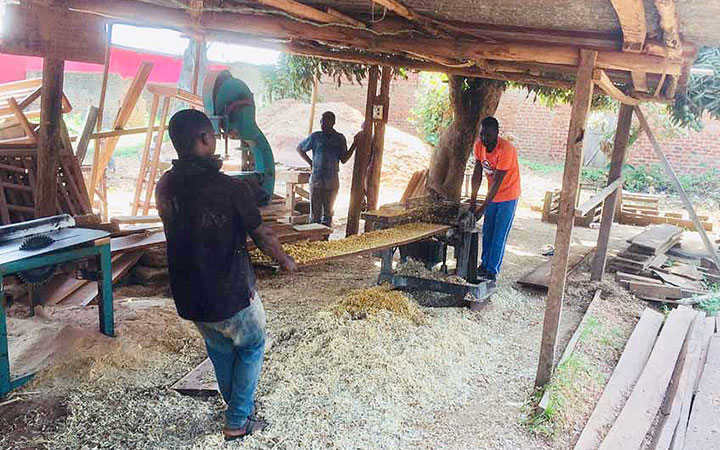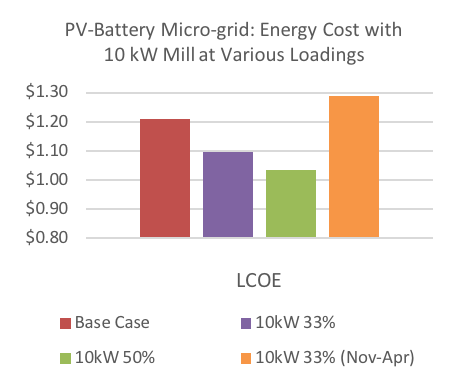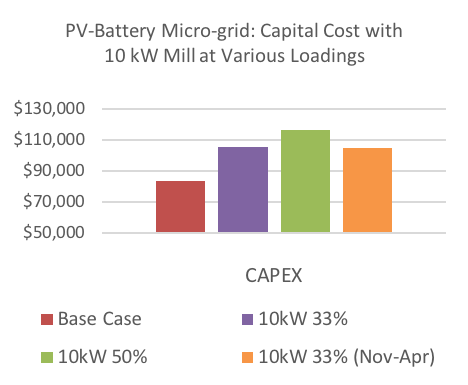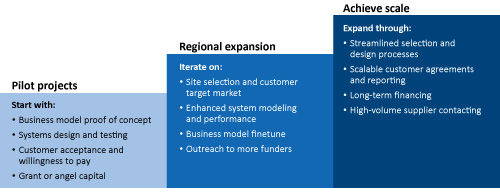Microgrids Can Help Sub-Saharan Africa Achieve Universal Energy Access
The USAID-NREL Partnership is helping to build an environment that could enable bankable, microgrid investments in Sub-Saharan Africa.

Microgrids can supply power for economic development. Photo from Peter Weston, Energy 4 Impact


Levelized cost of energy and capital cost for a photovoltaic-battery system with a maize mill in Tanzania. Analysis by NREL
According to the International Energy Agency (IEA), an estimated 1.1 billion people still lack access to modern electricity services—and roughly 600 million of them live in Sub-Saharan Africa. Furthermore, achieving universal energy access by 2030 is expected to require an investment of roughly $45 billion every year.
To help encourage private investment in this monumental task, NREL conducted analyses on African microgrids: one on the productive use of energy and the other on customer agreement considerations.
Productive Use of Energy in African Microgrids
NREL’s analysis focuses on the productive use of energy in microgrids, which is a key success factor for attracting investment and can be a barrier for small microgrids. This report, written in cooperation with Energy for Impact, is designed to help entrepreneurs and developers understand the technical and business model challenges related to PU in smaller microgrids.
The report provides actual customer demographics and productive use load profiles on microgrids operated by PowerGen Renewable Energy in Tanzania. One analysis looks at a microgrid in Tanzania that includes a maize mill. It compares a base case with cases in which the mill is operated under various loading scenarios, such as 33% loading (2.6 hours per day), 50% loading (4 hours per day), and seasonal operation. Some of these scenarios increase costs while others decrease costs. Overall, the analysis can help developers make informed decisions about when to add productive use loads to their microgrids.
Download the Report
Productive Use of Energy in African Micro-Grids: Technical and Business Considerations
DownloadCustomer Agreement Considerations for African Microgrids
The Customer Agreement Considerations report focuses on the agreement between microgrid developers and their customers. It highlights several examples from NREL’s partners about current microgrid development approaches. It also highlights how the agreements could be approved. There is a need for stronger agreements that could support the industry’s effort to serve the millions on the Sub-Saharan African subcontinent who still lack reliable electricity.

Most developers are in the initial phase of regional expansion, but scale is required to achieve energy access goals. Illustration by Eric Lockhart, NREL
Download the Report
Customer Agreement Considerations for Micro-Grids in Sub-Saharan Africa
DownloadPower Africa
Power Africa is a USAID-led partnership that brings together technical experts, the private sector, and governments from around the world to access to power in Africa. NREL supports Power Africa by focusing on implementing a mini and microgrid quality assurance framework and providing technical assistance that supports Power Africa’s goal of developing 8-10 million new electrical connections from mini and microgrids.
Learn more about Power Africa.
Sources:
IEA, Energy Access Outlook 2017: From Poverty to Prosperity
IEA, Energy for All: Financing Access for the Poor (2011)
Share

